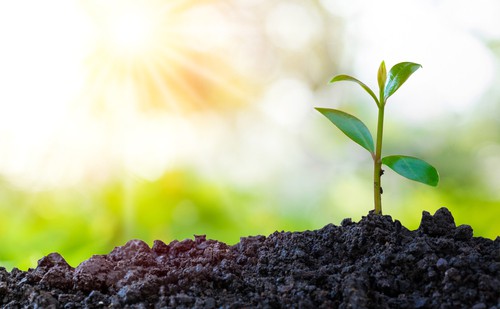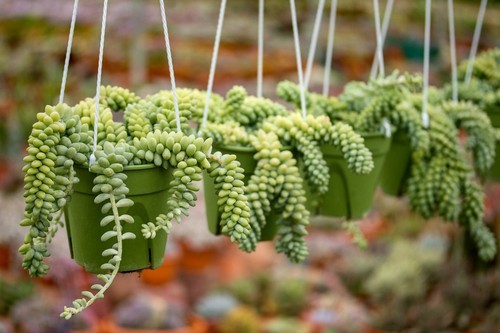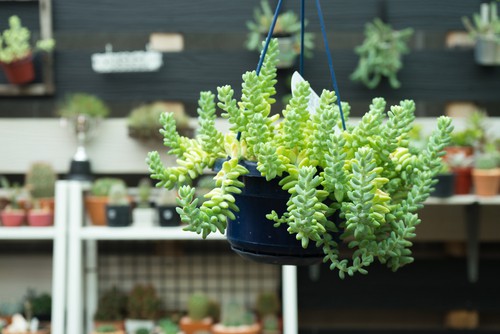Burro’s Tail is a popular succulent known for its delicate leaves and trailing stems. One of the most common concerns among Burro’s Tail plant owners is the yellowing of its leaves. While this can be alarming, it is a common issue that can be easily prevented and treated.
Understanding burro’s tail turning yellow is key to preventing and treating the issue. One possible cause of yellowing is overwatering, which can lead to root rot and ultimately cause the leaves to turn yellow.
Another potential cause is a lack of nutrients, particularly nitrogen, phosphorus, or potassium. Additionally, exposure to direct sunlight can cause the leaves to turn yellow and even burn.
Key Takeaways
- Yellowing of Burro’s Tail leaves is a common issue that can be easily prevented and treated.
- Overwatering, lack of nutrients, and exposure to direct sunlight are common causes of yellowing.
- Preventative measures such as proper watering and placement, as well as treatment options such as fertilization and pruning, can help keep Burro’s Tail healthy and vibrant.
Related posts:
- Brussel Sprouts Turning Yellow
- Birds of Paradise Turning Yellow
- Bird’s Nest Fern Leaves Turning Yellow
Understanding Burro’s Tail Yellowing

Burro’s tail, also known as sedum morganianum, is a popular succulent plant that has long, trailing stems covered in thick, fleshy, blue-green leaves. However, sometimes the leaves of the burro’s tail plant turn yellow, which can be a cause for concern for plant owners.
Yellowing leaves on a burro’s tail can be caused by a variety of factors. One common cause is overwatering, which can lead to root rot and cause the leaves to turn yellow and eventually fall off. On the other hand, underwatering can also cause the leaves to turn yellow and dry out.
Another reason for yellowing leaves on a burro’s tail plant is aging. As the plant ages, the older leaves at the base of the stem will naturally turn yellow and fall off, making room for new growth.
Additionally, a lack of nutrients can also cause the leaves to turn yellow. If the plant is not getting enough nitrogen, phosphorus, or potassium, the green leaves will start to turn yellow. Fertilizing the plant with a balanced fertilizer can help solve this problem.
It is important to note that some yellowing of the leaves on a burro’s tail plant is normal and nothing to be concerned about. However, if the yellowing is excessive or accompanied by other symptoms such as wilting or mold growth, it may be a sign of a more serious problem.
Burro’s Tail Turning Yellow
Burro’s tail, also known as sedum morganianum, is a beautiful trailing succulent that is easy to care for. However, it is not uncommon for its leaves to turn yellow, which can be a sign of an underlying problem. Here are some of the common causes of yellowing in burro’s tail.
1. Overwatering and Underwatering
Overwatering is one of the most common reasons for yellowing in burro’s tail. The roots of the plant can rot if they are constantly exposed to too much water, which can lead to yellowing and even death.
On the other hand, if the plant is not watered enough, the leaves may also turn yellow and dry out. It is essential to find the right balance and water the plant only when the soil is dry to the touch.
2. Inadequate Sunlight

Burro’s tail requires bright, indirect sunlight to thrive. If the plant is not getting enough light, its leaves may turn yellow and drop off. On the other hand, if the plant is exposed to too much direct sunlight, the leaves may also turn yellow and dry out. It is crucial to find the right balance and provide the plant with bright indirect sunlight.
3. Improper Temperature
Burro’s tail prefers warm temperatures and does not do well in frost or freezing temperatures. If the plant is exposed to extreme temperatures, its leaves may turn yellow and drop off. It is essential to maintain a temperature range between 60-80°F to keep the plant healthy.
4. Poor Soil and Drainage
Burro’s tail requires well-draining soil to prevent the roots from rotting. If the soil is not draining properly, the roots may be constantly exposed to too much water, leading to yellowing and even death.
It is recommended to use cactus or succulent soil mixed with perlite or coarse sand to ensure proper drainage. Additionally, it is crucial to ensure that the pot has drainage holes to allow excess water to escape.
5. Pest Infestation
Pests such as mealybugs, spider mites, aphids, and scale insects can feed on the sap of the plant, causing yellowing and weakening the plant. It is recommended to regularly inspect the plant for any signs of infestation and treat it with insecticidal soap or rubbing alcohol.
6. Plant Aging and Disease
As burro’s tail ages, its leaves may naturally turn yellow and drop off. Additionally, the plant may be susceptible to root rot, which can cause the leaves to turn yellow and drop off. It is recommended to regularly inspect the plant for any signs of disease and remove any affected parts immediately.
Prevention and Treatment
Burro’s tail plants are generally low maintenance, but it is important to take certain precautions to prevent the leaves from turning yellow. Here are some tips to keep your burro’s tail healthy and vibrant.
1. Proper Watering

Overwatering is the most common cause of yellowing leaves in burro’s tail plants. These plants are succulents and store water in their leaves, which means they do not need to be watered frequently. It is recommended to water the plant only when the soil is dry to the touch.
It is also important to use well-draining soil and a pot with drainage holes to prevent water from accumulating in the soil. If the soil is too moist, the roots may rot, which will cause the leaves to turn yellow.
2. Sunlight Adjustment
Burro’s tail plants require bright light, but direct sunlight can be harmful to the plant. It is recommended to place the plant in a location with indirect sunlight or partial sunlight for 6-8 hours a day. If the plant is not getting enough light, the leaves may turn yellow.
3. Temperature Control
Burro’s tail plants prefer warm temperatures between 60-75°F (15-24°C). If the plant is exposed to temperatures below 50°F (10°C), the leaves may turn yellow and drop off. It is important to keep the plant away from drafty areas and cold windows.
4. Soil and Drainage Improvement
Burro’s tail plants require well-draining soil to prevent water from accumulating in the soil. It is recommended to use a soil mix that is specifically designed for succulents. Adding perlite or sand to the soil can also improve drainage.
5. Pest Control
Pests such as mealybugs, spider mites, and aphids can also cause yellowing leaves in burro’s tail plants. These pests feed on the sap of the plant, which can weaken it and cause the leaves to turn yellow. It is recommended to inspect the plant regularly for signs of pests and to treat them promptly.
6. Plant Care and Maintenance
Pruning can help prevent yellowing leaves by promoting healthy growth and removing dead or damaged leaves. It is also important to fertilize the plant with a balanced fertilizer every two to three months during the growing season.
By following these tips, you can prevent your burro’s tail plant from turning yellow and keep it healthy and vibrant.
Propagation of Burro’s Tail

Burro’s tail is a popular succulent that can be propagated easily through stem cuttings or leaf cuttings. Propagating burro’s tail is a great way to create new plants and share them with friends and family.
To propagate burro’s tail through stem cuttings, choose a healthy stem that is at least 4 inches long. Use a sharp, clean pair of scissors to cut the stem at a 45-degree angle.
Allow the cutting to dry for a few days until the cut end has calloused over. Once the cutting has calloused, plant it in well-draining soil and water sparingly until new growth appears.
Leaf cuttings can also be used to propagate burro’s tail. Choose a healthy leaf and use a sharp, clean pair of scissors to cut it close to the stem. Allow the leaf to dry for a few days until the cut end has calloused over. Once the leaf has calloused, plant it in well-draining soil and water sparingly until new growth appears.
When propagating burro’s tail, it is important to use well-draining soil and to avoid overwatering. Overwatering can lead to root rot and cause the plant to turn yellow or die.
Burro’s Tail in Different Environments
Burro’s Tail is a succulent plant that is native to Mexico and is known for its plump, trailing leaves that resemble a donkey’s tail. This plant is popular as an indoor plant and is often grown in hanging baskets.
Burro’s Tail is a low maintenance plant and can thrive in a variety of environments, but it is important to understand how different environments can affect the plant’s growth and health.
1. Indoor Plant
Burro’s Tail is a popular indoor plant due to its unique appearance and low maintenance requirements. When grown indoors, this plant prefers bright, indirect sunlight. Direct sunlight can scorch the leaves and cause them to turn yellow.
It is recommended to place the plant near a window that receives bright, indirect sunlight for a few hours a day.
2. Hanging Baskets
Burro’s Tail is often grown in hanging baskets, which allows the plant to trail and show off its unique foliage. When grown in a hanging basket, it is important to ensure that the soil is well-draining and the basket has adequate drainage holes. Overwatering can lead to root rot, which can cause the leaves to turn yellow and fall off.
3. Shade
Burro’s Tail is a succulent plant and can tolerate some shade, but it still needs bright, indirect sunlight to thrive. If the plant is not receiving enough light, the leaves may start to turn yellow and fall off. It is recommended to place the plant near a window that receives bright, indirect sunlight for a few hours a day.
4. Direct Sun
Direct sunlight can be harmful to Burro’s Tail and can cause the leaves to turn yellow and fall off. It is recommended to place the plant near a window that receives bright, indirect sunlight for a few hours a day. If the plant is placed in an area with direct sunlight, it is important to provide some shade to protect the leaves.
5. Bright, Indirect Sunlight
Burro’s Tail prefers bright, indirect sunlight and can thrive in this type of environment. If the plant is not receiving enough light, the leaves may start to turn yellow and fall off. It is recommended to place the plant near a window that receives bright, indirect sunlight for a few hours a day.
Additional Information on Burro’s Tail

Burro’s tail, also known as donkey’s tail or Sedum morganianum, is a popular trailing succulent plant that is native to southern Mexico and Honduras. It is a member of the Crassulaceae family and can grow up to 2 feet long.
The plant produces long, trailing stems covered in densely packed light green leaves that resemble little knobs. In healthy plants, the leaves grow very close together, even overlapping in spots.
Burro’s tail requires well-draining soil and good drainage is essential for its growth. The plant is susceptible to root rot if the soil is too moist. It is recommended to use a mixture of potting soil and perlite to ensure proper drainage.
During the growing season, the plant requires regular watering, but it should be allowed to dry out completely before watering again. During the dormant season, watering should be reduced to once a month.
Burro’s tail is a low-maintenance plant that does not require frequent fertilizing. However, it can benefit from a balanced fertilizer with a low nitrogen and high phosphorus content during the growing season. Fertilizing should be done sparingly, no more than once a month.
It is important to note that burro’s tail is poisonous to cats and other animals. If ingested, it can cause vomiting and diarrhea. Therefore, it is recommended to keep the plant out of reach of pets.
Repotting should be done every 2-3 years, or when the plant has outgrown its container. When repotting, it is important to ensure that the new pot has good drainage and that the soil is well-draining.
Burro’s tail prefers bright, indirect light and can be sensitive to direct sunlight. It also prefers high humidity, so misting the plant occasionally can be beneficial.
Frequently Asked Questions
How do I revive a dying burro’s tail plant?
Reviving a dying burro’s tail plant can be a challenging task, but it is not impossible. The first step is to identify the cause of the problem. If the plant is overwatered, you should stop watering it immediately and let the soil dry out completely before watering it again.
If the plant is underwatered, you should water it more frequently and make sure the soil is moist but not waterlogged. You can also try repotting the plant in fresh soil and reducing the amount of direct sunlight it receives.
What are the signs of overwatering a burro’s tail plant?
Overwatering is one of the most common causes of a dying burro’s tail plant. The signs of overwatering include yellowing leaves, mushy stems, and a foul odor coming from the soil.
The plant may also start to wilt and become limp. If you suspect that your plant is overwatered, you should stop watering it immediately and let the soil dry out completely before watering it again.
How often should I water my burro’s tail plant?
Burro’s tail plants are succulents and do not require frequent watering. In general, you should water the plant once every two to three weeks during the growing season and once a month during the dormant season.
However, the frequency of watering may vary depending on the humidity, temperature, and amount of sunlight the plant receives. It is important to let the soil dry out completely between waterings to prevent overwatering.
Why is my burro’s tail plant turning yellow?
There are several reasons why a burro’s tail plant may turn yellow, including overwatering, underwatering, lack of sunlight, and nutrient deficiencies.
If the plant is overwatered or underwatered, you should adjust your watering schedule accordingly. If the plant is not getting enough sunlight, you should move it to a brighter location. Nutrient deficiencies can be corrected by fertilizing the plant with a balanced fertilizer.
What are the common causes of a shriveling donkey tail plant?
A shriveling donkey tail plant is usually a sign of underwatering or overwatering. If the plant is underwatered, the leaves will start to shrivel and become dry.
If the plant is overwatered, the leaves will become mushy and may fall off. Other causes of a shriveling plant include pests, diseases, and nutrient deficiencies. It is important to identify the cause of the problem and take appropriate action to save the plant.
How can I save my donkey tail succulent from dying?
To save a dying donkey tail succulent, you should identify the cause of the problem and take appropriate action. If the plant is overwatered, you should stop watering it immediately and let the soil dry out completely before watering it again.
If the plant is underwatered, you should water it more frequently and make sure the soil is moist but not waterlogged. Other common causes of a dying plant include pests, diseases, and nutrient deficiencies.
You can also try repotting the plant in fresh soil and reducing the amount of direct sunlight it receives.

Hey, I’m Lisa and I’ve been an avid gardener for over 30 years. I love writing, talking and living in the garden! Feel free to connect with me on my socials below


